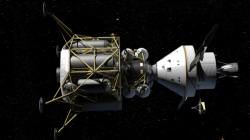NASA’s Constellation Program has released an announcement that they are looking for people to evaluate the design of the Altair spacecraft that will land on the moon. So if you work in the science community or in a related industry, NASA wants your opinion. What they are looking for are evaluations of the current developmental concept for the Altair lander and the safety improvements that have been proposed, as well as recommendations for industry-government partnerships.
“By soliciting ideas and suggestions from industry and the science community, NASA hopes to foster a collaborative environment during this early design effort,” said Jeff Hanley, the Constellation Program manager. “Such collaboration will support the development of a safe, reliable and technologically sound vehicle for our crews.”
All you have to do is write a proposal and submit it to NASA by jumping through the various hoops found here. NASA expects to award contracts for the studies of the Altair spacecraft in the first quarter of 2008. A total of $1.5 million is available for awards. The maximum individual award amount is $350,000. The contract performance period is six months.
In NASA-speak, proposals are due “30 days from the issue date of Jan. 11.” By my calculations, that is February 10, which is a Sunday, an odd day to have a proposal due since most of NASA’s offices are closed. Maybe its a subtle hint to get your proposals in early.
The Altair spacecraft will bring four astronauts to the lunar surface, and missions are currently scheduled to begin late in the next decade. NASA plans call for establishing an outpost on the moon through their lunar missions beginning no later than 2020.
The Constellation Program, based at NASA’s Johnson Space Center, Houston, manages the Altair Project for NASA’s Exploration Systems Mission Directorate. Constellation is developing a new space transportation system that is designed to travel beyond low Earth orbit. The Constellation fleet includes the Orion crew exploration vehicle, the Ares I and Ares V launch vehicles and Altair human lunar lander.
Find more information about the Constellation Program here.
Original News Source: NASA Constellation Program Press Release


